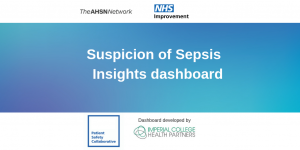 NHS launches sepsis tool to improve efforts to tackle deadly infection
NHS launches sepsis tool to improve efforts to tackle deadly infection
Today, the NHS has launched a tool that for the first time accurately measures the number of patients admitted to hospital who are at risk of sepsis, which is notoriously difficult to detect.
Sepsis is a life-threatening condition that claims approximately 37,000 lives a year, although the exact figure is difficult to determine. It is caused when the body responds poorly to a bacterial infection and attacks its own tissues and organs. Sepsis is notoriously difficult to spot because there is no clear diagnostic test for the condition.
For the first time, the NHS will now be able to track improvements – such as rates of survival and length of hospitals stays. Now all hospitals across England are being asked to use a tool which will allow them to identify how many patients are at risk of sepsis.
Executive Medical Director at NHS Improvement and Chief Operating Officer, Kathy McLean said:
“The NHS has made huge developments in tackling sepsis but it could still go further.
“Not having an agreed definition of sepsis has made interventions difficult as the NHS has not been able to accurately report how many people are falling victim to this deadly condition or which treatments are most effective.
“That is why it is vital that this tool is used by all A&Es to help ensure that we start reporting the true scale of this life-threatening condition, so that improvements can be made.”
The number of recorded cases of sepsis in the NHS has significantly increased in recent years thanks to better detection and reporting of the condition by NHS staff.
But without a clear consistent definition of sepsis, it has previously been impossible to properly track improvements or accurately report on how many people are falling victim to this deadly infection.
This NHS tool will for the first time measure the number of patients coming into hospital as an emergency with a severe bacterial infection categorised as of “suspicion of sepsis”. Previously the measurement for sepsis has fluctuated but this tool gives serious infections a defined category that all organisations in the NHS will use, identifying patients who should be screened for sepsis and giving clinicians the most accurate picture yet for how many people are at risk of developing sepsis.
Celia Ingham Clark, medical director for clinical effectiveness at NHS England, said:
“More cases of sepsis are being spotted and treated than ever before and NHS England is working closely with the UK Sepsis Trust and medical leaders on awareness-raising to ensure that the signs of sepsis are spotted as soon as possible. This new dashboard is another valuable tool to help equip organisations to drive further improvements.”
The tool will help spot whether these interventions are having an impact on patients locally, regionally and nationally.
By showing the numbers of admissions, rates of survival, and lengths of stay, it will give clinicians the clearest information yet for which types of infections can cause patients to deteriorate quickly, and which treatments are most effective at saving lives.
The Suspicion of Sepsis (SOS) Dashboard has been created by Imperial College Health Partners (ICHP) through the Patient Safety Collaborative, in collaboration with NHS Improvement and NHS England, and building on the methodology for measuring sepsis previously published by Oxford Academic Health Science Network.
It was introduced on World Sepsis Day to Celia Ingham Clark, NHS England’s Medical Director for Clinical Effectiveness, alongside Care Minister Caroline Dinenage at Imperial College Healthcare NHS Trust.
Secretary of State for Health and Social Care, Matt Hancock, said;
“Sepsis is a devastating condition that is notoriously tricky to diagnose, so I’m delighted to support this important new tool. Not only will it let clinicians understand the impact of different interventions for sepsis, but crucially, in the future it could help analyse which infections lead to sepsis more often. It is yet another example of how technology is improving patient care in the NHS.”
Notes to editors:
- Changes in coding patients with Sepsis and increased Sepsis awareness has led to numbers of NHS patients identified with Sepsis to ‘increase’ artificially. Importantly even with this ‘increased’ awareness and coding changes mortality rates for all cause emergency Sepsis admissions have gone down. There were 2 million suspicion of sepsis admissions in England last year compared to 1.2 million 5 years ago.
About NHS Improvement
NHS Improvement is responsible for overseeing foundation trusts, NHS trusts and independent providers. We offer the active support these frontline providers need to give patients consistently safe, high quality, compassionate care within local health systems that are financially sustainable. By holding providers to account and, where necessary, intervening, we help the NHS to meet its short-term challenges and secure its future.
NHS Improvement brings together Monitor, the NHS Trust Development Authority plus groups from three other organisations: from NHS England both the Patient Safety Team and the Advancing Change Team, from NHS Interim Management and Support two Intensive Support Teams, together with the National Reporting and Learning System team. NHS Improvement is an operational name for the organisation which formally comes into being on 1 April 2016.
Follow NHSI on Twitter @NHSImprovement
About NHS England
NHS England leads the National Health Service (NHS) in England – setting the priorities and direction, encouraging and informing the national debate to improve health and care.
The NHS in England deals with over 1 million patients every 36 hours and employs more than 1.5 million people, putting it in the top five of the world’s largest workforces NHS England shares out more than £100 billion in funds and holds organisations to account for spending this money effectively for patients and efficiently for the tax payer. It strongly believes in health and high quality care for all, now and for future generations.
Imperial College Health Partners
Imperial College Health Partners (ICHP) innovates and collaborates for a healthier population. We turn the potential of innovation into reality to help solve pressing challenges by collaborating across the health sector. By connecting a unique network of health experts we can accelerate the adoption and spread of innovation amongst our member organisations.
Imperial College Health Partners is a partnership organisation bringing together NHS providers of healthcare services, clinical commissioning groups and leading universities across North West London.
We are also the designated Academic Health Science Network (AHSN) for North West London and a member of The AHSN Network.



